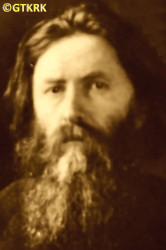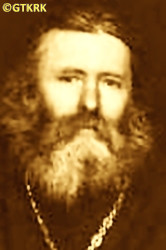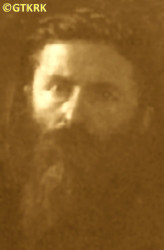Roman Catholic
St Sigismund parish
05-507 Słomczyn
85 Wiślana Str.
Konstancin deanery
Warsaw archdiocese, Poland
full list:
displayClick to display full list

searchClick to search full list by categories
wyświetlKliknij by wyświetlić pełną listę po polsku

szukajKliknij by przeszukać listę wg kategorii po polsku

Martyrology of the clergy — Poland
XX century (1914 – 1989)
personal data
surname
DIERNOW
forename(s)
Anatol
religious forename(s)
Abramius (pl. Abrahamiusz)

function
archbishop
creed
Eastern Orthodox Church ORmore on
en.wikipedia.org
[access: 2014.09.21]
diocese / province
Vyatka OR eparchymore on
en.wikipedia.org
[access: 2020.09.24]
academic distinctions
Sacred Orthodox Theology Candidate
nationality
Russian
date and place
of death
01.05.1942

ITL SorokLagGuLAG slave labour camp network
today: Kodino, Kodino, Onega reg., Arkhangelsk oblast, Russia
more on
en.wikipedia.org
[access: 2023.07.16]
details of death
During World War I after Russian defeat by German and Austro–Hungarian troops at battle of Gorlice in 05.1915 escaped to Russia (mass exodus).
For a short time stayed in Vysokopetrovsky monastery in Moscow though lost archimandrite post.
Without a post in the Church lived in Moscow, Kazan and next in Glazov, where he was brought up.
Arrested for the first time on 27.12.1923 prob. in Urzhum.
Released in 05.1924, without the right to leave town.
Arrested again on 06.02.1925 (or late 1925) — apprehended at the Assumption cathedral when approached the pulpit to make a homily.
Accused of helping other exiled bishops.
Sentenced by Russian OGPU court to 3 years of exile.
Lived in Glibyi Ad in Komi republic.
Released in 03.1928 but unable to return to Uzhum.
For a year lived in Kamishin in Volgograd oblast.
Next settled in Glazov.
In 1931 as Glazov bishop again sentenced for „anti–Russian agitation” for a year in slave labour in Russian concentration camps.
Formally then retired.
In 1933‐1934 however was back in Glazov ministering in Transfiguration cathedral.
Later, again as Glazov bishop, lived in a cathedral's gatehouse.
At the beginning of 1937 the cathedral was closed by Russians, under pretext of necessary renovations.
From then on ministered in his apartment, starting at 04:00 in the morning each day.
On 10.05.1937 arrested again.
Held in Glazov prison.
Accused of „anti–Russian propaganda, leading illegal meetings in his apartment where Russian authorities were slandered during discussions”.
On 04.11.1937 sentenced in Glazov to 10 years in prison.
Held in Izhevsk prison.
On 30.08.1938 a decision was taken to sent him to one of the concentration camps in north–eastern Russia.
However, he was still in Izhevsk prison on 22.06.1939, when protested against his incarceration.
Immediately after that, by order of 30.08.1939, sent north, towards the White Sea. On the way, briefly held in Saint Petersburg prison, and then on the Solovetsky Islands (a prison established by the communists in 1937 after the closure of the ITL SLON concentration camp).
02.11.1939 transported to the ITL SorokLag concentration camp, where initially slaved in the village of Sumskyi Posad, and from 09.1940 in Belomorsk, then the center of the camp.
Despite suffering myocarditis and atherosclerosis, forced to work hard, only deafness in both ears meant that on 16.03.1942, totally exhausted, was placed in the camp „hospital” in the new center of the camp in the village of Kodino.
Perished there soon.
cause of death
extermination
perpetrators
Russians
sites and events
ITL SorokLagClick to display the description, ITL SLONClick to display the description, GulagClick to display the description, Great Purge 1937Click to display the description, Forced exileClick to display the description
date and place
of birth
29.07.1874

Upper Parzitoday: Glazov reg., Udmurt rep., Russia
more on
ru.wikipedia.org
[access: 2020.09.24]
parents
DIERNOW John
🞲 1837, ? — 🕆 1899, ?

FLOROWA Theoctista
🞲 01.01.1836, Yukamenskoyetoday: Yukamensky reg., Udmurt rep., Russia
more on
en.wikipedia.org
[access: 2025.03.18] — 🕆 ?, ?
religious vows
31.03.1900 (permanent)
presbyter (holy orders)
ordination
1900

positions held
07.01.1937
archbishop — Russian Orthodox Church — dignity conferment
14.05.1935 – 1937
auxiliary bishop — Glazovtoday: Glazov city reg., Udmurt rep., Russia
more on
en.wikipedia.org
[access: 2023.07.16] ⋄ vicariate, Russian Orthodox Church ⋄ Vyatka‐Slobodskoy OR eparchy
1934 – 1935
retired (i.e. „at rest”) — Glazovtoday: Glazov city reg., Udmurt rep., Russia
more on
en.wikipedia.org
[access: 2023.07.16] ⋄ Vyatka‐Slobodskoy OR eparchy
22.02.1929 – 1931
auxiliary bishop — Glazovtoday: Glazov city reg., Udmurt rep., Russia
more on
en.wikipedia.org
[access: 2023.07.16] ⋄ vicariate, Russian Orthodox Church ⋄ Vyatka‐Slobodskoy OR eparchy — till anothe arrest and exile by the communists
16.09.1923 – 1927
bishop — Vyatkatoday: Kirov, Kirov city reg., Kirov oblast, Russia
more on
en.wikipedia.org
[access: 2022.02.06] ⋄ Russian Orthodox Church ⋄ Vyatka‐Slobodskoy OR eparchy — Lat. locum tenens (Eng. „holding reins”), acting („ad interim”), during the arrest of Archbishop Viatka by the communists (with breaks when he himself was arrested)
16.09.1923 – 22.02.1929
auxiliary bishop — Urzhumtoday: Urzhum urban, Urzhum city reg., Russia
more on
en.wikipedia.org
[access: 2023.07.16] ⋄ vicariate, Russian Orthodox Church ⋄ Vyatka‐Slobodskoy OR eparchy — with breaks for prison and exile: 27.12.1923‐05.1924 and 06.02.1925‐03.1928; released in 03.1928, but without the right to return to Urzhum; for several months resided in the city of Kamyshin in the Volgograd Oblast, and then in Glazow in his eparchy, still without the right to return to Urzhum
16.09.1923
Bishop — Moscowtoday: Moscow city, Russia
more on
en.wikipedia.org
[access: 2020.07.31] ⋄ Russian Orthodox Church — bishop's cheirotonia, i.e. ordination
1920 – 1923
hegumen–superior — Vyatkatoday: Kirov, Kirov city reg., Kirov oblast, Russia
more on
en.wikipedia.org
[access: 2022.02.06] ⋄ Dormition of the Blessed Virgin Mary OR monastery (Tryphon's monastery)
c. 1917
hegumen–superior — Sankt Petersburgtoday: Saint Petersburg city, Russia
more on
en.wikipedia.org
[access: 2020.07.31] ⋄ St Alexander Nevsky OR Lavra — prob.
1910 – 1915
hegumen–superior — Supraśltoday: Supraśl gm., Białystok pov., Podlaskie voiv., Poland
more on
en.wikipedia.org
[access: 2022.01.06] ⋄ Annunciation to the Blessed Virgin Mary OR monastery — with the title of Achimandrite
c. 1901 – c. 1909
membership — Semipałatyńsktoday: Semey, East Kazakhstan reg., Kazakhstan
more on
en.wikipedia.org
[access: 2023.07.16] ⋄ Russian Orthodox Church mission — mission „in Kyrgyzya”
1900
hieromonk — Russian Orthodox Church — priesthood cheirotonia, i.e. ordination, preceded by deacon cheirotonia and on 31.03.1900 by monk’s vows
1897 – 1901
student — Kazantoday: Kazan city reg., Tatarstan rep., Russia
more on
en.wikipedia.org
[access: 2022.02.04] ⋄ Orthodox Theological Academy — postgraduate specialised studies, crowned with the right to receive the title of Candidate of Sacred Theology without the need for „additional oral exams”
till c. 1897
student — Vyatkatoday: Kirov, Kirov city reg., Kirov oblast, Russia
more on
en.wikipedia.org
[access: 2022.02.06] ⋄ philosophy and theology, Orthodox Theological Seminary
others related
in death
KULHAWIECClick to display biography Simeon, STEPANIUKClick to display biography George, GUDKOClick to display biography Basil (Bp Ambrose), NIKATOWClick to display biography Alex, OSTROUMOWClick to display biography Michael (Bp Seraphim), SAWICKIClick to display biography Yaroslav, SIENKIEWICZClick to display biography Alex, GAGALUKClick to display biography Anthony (Abp Onuphrius), STROCIUKClick to display biography Leontius, BLUMOWICZClick to display biography John, SZACHMUĆClick to display biography Roman (Fr Seraphim), PANASIEWICZClick to display biography Emilian, MIEDWIEDIUKClick to display biography Vladimir, SMOLENIECClick to display biography Alexander (Abp Arsenius), MARCENKOClick to display biography Alexander (Abp Anthony), BORZAKOWSKIClick to display biography Alexander (Abp Agapit)
sites and events
descriptions
ITL SorokLag: Russian Rus. Исправи́тельно‐Трудово́й Ла́герь (Eng. Corrective Labor Camp) ITL Rus. Сорокский (Eng. Sorokskiy) — concentration and slave forced labor camp (within the Gulag complex) — headquartered in Belomorsk in Republic of Karelia (till 1938 known as Soroky) and then in Kodino in Arkhangelsk Oblast. Founded on 07.05.1938. Prisoners slaved at the construction of the second track of the Belomorsk‐Murmansk railway line and the Belomorsk‐Plesetsk railway line (with the railway station in Obozerskaya), ethyl alcohol distilleries (in the hydrolysis process) in Belomorsk and Onega, in the operation of railway lines, etc. At its peak c. 52,000 prisoners were held there: e.g. 17,360 (01.10.1938); 17,458 (01.01.1939); 17,941 (01.01.1940); 52,379 (01.01.1941); 40,164 (01.07.1941); 21,725 (01.01.1942); 22,289 (01.04.1942). Ceased to exist on 08.04.1942. (more on: old.memo.ruClick to attempt to display webpage
[access: 2024.04.08])
ITL SLON: Russian Rus. Исправи́тельно‐Трудово́й Ла́герь (Eng. Corrective Labor Camp) ITL Rus. Солове́цкий ла́герь осо́бого назначе́ния Ла́герь (Eng. Solovetsky Special Purpose Camp) SLON — concentration and slave forced labor camp (within what was to become Gulag complex) — headquartered in Solovetsky Islands in Arkhangelsk Oblast. Founded on 13.10.1923 in a famous Orthodox monastery. In the 1920s, one of the first and largest concentration camps in Russia. The place of slave labor of prisoners — at forest felling, sawmills, peat extraction, fishing, loading work on the Murmansk Railway Main Line, in road construction, production of food and consumer goods, at the beginning of the construction of the White Sea ‐ Baltic canal, etc. The concept of the later system of Russian Gulag concentration camps prob. had its origins in the Solovetsky Islands camp — from there the idea spread to the camps in the area covered by the construction of the White Sea ‐ Baltic canal, i.e. ITL BelBaltLag, and from there further, to the entire territory of the Russian state. From the network of camps on the Solovetsky Islands — also called the Solovetsky Islands archipelago — prob. also comes the concept of the „Gulag Archipelago” created by Alexander Solzhenitsyn. It is estimated that tens to hundreds of thousands of prisoners passed through the Solovetsky Islands concentration camps. At its peak, c. 72,000 prisoners were held there: e.g. 14,810 (12.1927); 12,909 (03.1928); 65,000 (1929); 53,123 (01.01.1930); 63,000 (01.06.1930); 71,800 (01.01.1931); 15,130 (1932); 19,287 (1933) — c. 43,000 of whom were murdered, including the years 1937‐1938 when c. 9,500 prisoners were transported from the camp and murdered in several places of mass executions, including Sandarmokh, Krasny Bor and Lodeynoye Polye. Among them were many Catholic and Orthodox priests. After the National Socialist Party came to power in Germany in 1933, a German delegation visited the ITL SLON camp, to „inspect” Russian solutions and adopt them later in German concentration camps. It operated until 04.12.1933, with a break from 16.11.1931 to 01.01.1932, when it was part of and later became a subcamp of the ITL BelBaltLag camp. It operated as such until 1939 (from 1936 as a prison). (more on: old.memo.ruClick to attempt to display webpage
[access: 2024.04.08])
Gulag: The acronym Gulag comes from the Rus. Главное управление исправительно‐трудовых лагерей и колоний (Eng. Main Board of Correctional Labor Camps). The network of Russian concentration camps for slave labor was formally established by the decision of the highest Russian authorities on 27.06.1929. Control was taken over by the OGPU, the predecessor of the genocidal NKVD (from 1934) and the MGB (from 1946). Individual gulags (camps) were often established in remote, sparsely populated areas, where industrial or transport facilities important for the Russian state were built. They were modeled on the first „great construction of communism”, the White Sea‐Baltic Canal (1931‐1932), and Naftali Frenkel, of Jewish origin, is considered the creator of the system of using forced slave labor within the Gulag. He went down in history as the author of the principle „We have to squeeze everything out of the prisoner in the first three months — then nothing is there for us”. He was to be the creator, according to Alexander Solzhenitsyn, of the so‐called „Boiler system”, i.e. the dependence of food rations on working out a certain percentage of the norm. The term ZEK — prisoner — i.e. Rus. заключенный‐каналоармец (Eng. canal soldier) — was coined in the ITL BelBaltLag managed by him, and was adopted to mean a prisoner in Russian slave labor camps. Up to 12 mln prisoners were held in Gulag camps at one time, i.e. c. 5% of Russia's population. In his book „The Gulag Archipelago”, Solzhenitsyn estimated that c. 60 mln people were killed in the Gulag until 1956. Formally dissolved on 20.01.1960. (more on: en.wikipedia.orgClick to attempt to display webpage
[access: 2024.04.08])
Great Purge 1937: „Great Terror” (also «Great Purge», also called „Yezhovshchyna” after the name of the then head of the NKVD) — a Russian state action of political terror, planned and directed against millions of innocent victims — national minorities, wealthier peasants (kulaks), people considered opponents political, army officers, the greatest intensity of which took place from 09.1936 to 08.1938. It reached its peak starting in the summer of 1937, when Art. 58‐14 of the Penal Code about „counter‐revolutionary sabotage” was passed , which became the basis for the „legalization” of murders, and on 02.07.1937 when the highest authorities of Russia, under the leadership of Joseph Stalin, issued a decree on the initiation of action against the kulaks. Next a number of executive orders of the NKVD followed, including No. 00439 of 25.07.1937, starting the liquidation of 25,000‐42,000 Germans living in Russia (mainly the so‐called Volga Germans); No. 00447 of 30.07.1937, beginning the liquidation of „anti‐Russian elements”, and No. 00485[2] of 11.08.1937, ordering the murder of 139,835 people of Polish nationality (the latter was the largest operation of this type — encompassed 12.5% of all those murdered during the «Great Purge», while Poles constituted 0.4% of the population). In the summer of 1937 Polish Catholic priests held in Solovetsky Islands, Anzer Island and ITL BelbaltLag were locked in prison cells (some in Sankt Petersburg). Next in a few kangaroo, murderous Russian trials (on 09.10.1937, 25.11.1937, among others) run by so‐called «NKVD Troika» all were sentenced to death. They were subsequently executed by a single shot to the back of the head. The murders took place either in Sankt Petersburg prison or directly in places of mass murder, e.g. Sandarmokh or Levashov Wilderness, where their bodies were dumped into the ditches. Other priests were arrested in the places they still ministered in and next murdered in local NKVD headquarters (e.g. in Minsk in Belarus), after equally genocidal trials run by aforementioned «NKVD Troika» kangaroo courts.
Forced exile: One of the standard Russian forms of repression. The prisoners were usually taken to a small village in the middle of nowhere — somewhere in Siberia, in far north or far east — dropped out of the train carriage or a cart, left out without means of subsistence or place to live. (more on: en.wikipedia.orgClick to attempt to display webpage
[access: 2014.12.20])
sources
personal:
drevo-info.ruClick to attempt to display webpage
[access: 2020.09.24], translate.google.comClick to attempt to display webpage
[access: 2020.09.24]
original images:
drevo-info.ruClick to attempt to display webpage
[access: 2020.09.24], www.pstbi.ccas.ruClick to attempt to display webpage
[access: 2020.09.24], ru.openlist.wikiClick to attempt to display webpage
[access: 2020.09.24]
LETTER to CUSTODIAN/ADMINISTRATOR
If you have an Email client on your communicator/computer — such as Mozilla Thunderbird, Windows Mail or Microsoft Outlook, described at WikipediaPatrz:
en.wikipedia.org, among others — try the link below, please:
LETTER to CUSTODIAN/ADMINISTRATORClick and try to call your own Email client
If however you do not run such a client or the above link is not active please send an email to the Custodian/Administrator using your account — in your customary email/correspondence engine — at the following address:

giving the following as the subject:
MARTYROLOGY: DIERNOW Anatol
To return to the biography press below:
 Click to return to biography
Click to return to biography










